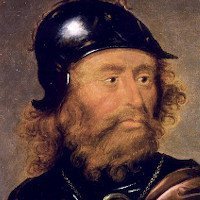His official title was Robert I (11 July 1274–7 June 1329) and he was King of Scots from March 25, 1306, until his death in 1329. Destined by a claim to the Scottish throne to become one of Scotland’s greatest Kings. The eighth in the family to bear the name, he led Scotland during the Wars of Scottish Independence against the English, claiming the Scottish throne in 1306 as the fourth great-grandson of David I of Scotland. During his reign he lived to see Scotland gain its status as an Independent Nation.
 Robert the Bruce’s paternal ancestors were originally form Normandy (Scots-Norman) and on his maternal side he was Franco-Gaelic. He was born in 1274 possibly in Ayrshire at Turnberry. Little is documented of his youth until at age 18 he was elevated to the Earldom of Carrick on his mothers death. At this time the claim to the Scottish throne was hotly contested when the throne became vacant after the untimely death of Alexander III when he fell from his horse. Edward I of England was quick to exploit the situation and appointed John Balliol as the rightful King Of Scotland. The Bruce family refused to accept Edward’s decision and Robert was instructed by his father to continue their claim to the throne.
Robert the Bruce’s paternal ancestors were originally form Normandy (Scots-Norman) and on his maternal side he was Franco-Gaelic. He was born in 1274 possibly in Ayrshire at Turnberry. Little is documented of his youth until at age 18 he was elevated to the Earldom of Carrick on his mothers death. At this time the claim to the Scottish throne was hotly contested when the throne became vacant after the untimely death of Alexander III when he fell from his horse. Edward I of England was quick to exploit the situation and appointed John Balliol as the rightful King Of Scotland. The Bruce family refused to accept Edward’s decision and Robert was instructed by his father to continue their claim to the throne.
Through time Balliol and Edward I disagreed and Balliol raised an army to challenge Edward. In 1292 Balliol was imprisoned in the Tower of London and thus began the rebellion within Scotland with the brutal murder of the Sheriff of Lanark by William Wallace in 1296 leading to many battles between the Scots and the English culminating in the Battle of Stirling bridge in 1297 with the English being defeated by Wallace and seeing Stirling Castle once again in Scottish hands. During this period Robert the Bruce sided with the English and in 1304 Stirling Castle was taken back by an English Army led by Edward.
By 1306 Robert was becoming impatient to assume the Crown of Scotland which he believed to be rightly his. In February of that year he killed his rival John Comyn at Dumfries and in March crowned himself King of Scotland.
Between 1310 and 1314 he won control of Northern Scotland. After capturing the Castles of Edinburgh and Roxburgh the only castle left in English hands was Stirling Castle. Because of his limited resources Bruce had to find a good strategy to defeat the English knights in Stirling. Therefore he decided to attack from a stream by Stirling called The Bannock Burn. This battle was one of the worst battles in English history and a great success for the Scots to gain control over their land again.
Today, Bruce is remembered as a Scottish National hero. His body is buried in Dunfermline Abbey and his heart is buried in Melrose Abbey. His embalmed heart was taken on a crusade to Spain on his request, by Sir James Douglas to fight against the Moors however Douglas was killed during the crusade but fortunately the heart in its silver casket was returned to Melrose Abbey.
A impressive statue to honour Bruce stands at the entrance to Stirling Castle which is open all year round to visitors and makes a great day out. The City of Stirling has many other places of interest on “The Top of The Town” and also the Wallace Monument near the University of Stirling.
